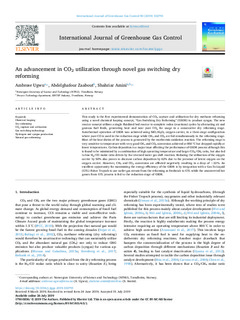| dc.contributor.author | Ugwu, Ambrose | |
| dc.contributor.author | Zaabout, Abdelghafour | |
| dc.contributor.author | Amini, Shahriar | |
| dc.date.accessioned | 2019-12-13T09:39:41Z | |
| dc.date.available | 2019-12-13T09:39:41Z | |
| dc.date.created | 2019-07-30T14:59:43Z | |
| dc.date.issued | 2019 | |
| dc.identifier.citation | International Journal of Greenhouse Gas Control. 2019, 90 1-13. | nb_NO |
| dc.identifier.issn | 1750-5836 | |
| dc.identifier.uri | http://hdl.handle.net/11250/2633102 | |
| dc.description.abstract | This study is the first experimental demonstration of CO2 capture and utilization for dry methane reforming using a novel chemical looping concept, “Gas Switching Dry Reforming” (GSDR) to produce syngas. The new reactor concept utilizes a single fluidized bed reactor to complete redox (reactions) cycles by alternating air and gaseous fuel feeds, generating heat and near pure CO2 for usage in a consecutive dry reforming stage. Autothermal operation of GSDR was achieved using NiO/Al2O3 oxygen carrier, in a three-stage configuration where pure CO is used in the reduction stage while CH4 and CO2 are fed simultaneously in the reforming stage. Most of the heat duties of the process is generated by the exothermic oxidation reaction. The reforming stage is very sensitive to temperature with very good CH4 and CO2 conversion achieved at 850 °C but dropped rapidly at lower temperatures. Carbon deposition is a major issue affecting the performance of GSDR process although this is found to be minimized by a combination of high operating temperature and larger CO2/CH4 ratio, but also led to low H2/CO molar ratio driven by the reversed water gas shift reaction. Reducing the utilization of the oxygen carrier by 50% also proves to decrease carbon deposition by 62% due to the presence of latent oxygen on the oxygen carrier. However, CH4 and CO2 conversion are affected negatively resulting in a drop of ∼22%. An excellent opportunity for maximizing the energy efficiency of the GSDR is by integration with a Gas-To-Liquid (GTL) Fisher Tropsch to use outlet gas stream from the reforming as feedstock to GTL while the unconverted hot gasses from GTL process is fed to the reduction stage of GSDR. | nb_NO |
| dc.language.iso | eng | nb_NO |
| dc.publisher | Elsevier | nb_NO |
| dc.rights | Attribution-NonCommercial-NoDerivatives 4.0 Internasjonal | * |
| dc.rights.uri | http://creativecommons.org/licenses/by-nc-nd/4.0/deed.no | * |
| dc.title | An advancement in CO2 utilization through novel gas switching dry reforming | nb_NO |
| dc.type | Journal article | nb_NO |
| dc.type | Peer reviewed | nb_NO |
| dc.description.version | publishedVersion | nb_NO |
| dc.source.pagenumber | 1-13 | nb_NO |
| dc.source.volume | 90 | nb_NO |
| dc.source.journal | International Journal of Greenhouse Gas Control | nb_NO |
| dc.identifier.doi | 10.1016/j.ijggc.2019.102791 | |
| dc.identifier.cristin | 1713291 | |
| dc.description.localcode | © 2019 The Authors. Published by Elsevier Ltd. This is an open access article under the CC BY-NC-ND license (http://creativecommons.org/licenses/BY-NC-ND/4.0/). | nb_NO |
| cristin.unitcode | 194,64,25,0 | |
| cristin.unitname | Institutt for energi- og prosessteknikk | |
| cristin.ispublished | true | |
| cristin.fulltext | original | |
| cristin.qualitycode | 2 | |

